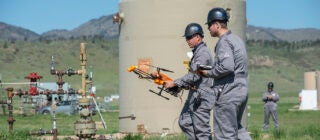- Resources
- Future ready regulations will catalyze innovation for the oil and gas industry
Resources
Future ready regulations will catalyze innovation for the oil and gas industry
Published: June 27, 2018 by EDF Staff
The oil and gas industry is at an inflection point: according to the International Energy Agency (IEA), the role that natural gas can play in the future of global energy is inextricably linked to its ability to help address environmental problems.
One of these problems is methane emissions–a key focus of the World Gas Conference in Washington, D.C. this week–which represent a reputational risk to the oil and gas industry, a waste of saleable resources, and a contributor to both poor local air quality and climate change. It comes as little surprise then that momentum to reduce methane emissions is building:
- Earlier this spring, BP announced a stringent, quantitative methane reduction target.
- Shell, ExxonMobil, Qatar Petroleum, and a host of other producers committed to continuously reduce methane emissions across the natural gas value chain.
- Investors representing $4.2 trillion in assets are calling on companies to improve their methane performance and better manage long-term business risk.
Meanwhile, entrepreneurs and innovators are ramping up development of tech solutions to help keep pace with this momentum, in part through innovation challenges and the new Oil and Gas Climate Initiative (OGCI) deployment accelerator.
Yet as the demand for solutions continues to grow, a key question remains: how can regulations help innovation move from pilots to widespread adoption?
Here’s a look at the current rules, and how future regulatory frameworks can accelerate methane innovation.

Pathways to innovation: following up on a promising star
tIn 2016, many innovators, forward-thinking oil and gas operators and Environmental Defense Fund (EDF) called on the Environmental Protection Agency EPA to include a “pathway to innovation” in their final new source performance standards rule. This provision was intended to allow operators to have more flexibility in complying with methane monitoring and emissions regulations, allowing them to invest in and deploy more effective and lower-cost solutions as they become available. It was based in part on Colorado’s Approved Instrument Monitoring Method, which was developed in collaboration between operators, the state, and environmentalists.
This promising start has not yet unlocked its full potential to encourage innovation in technology development. Regulators, companies and innovators have described a couple of areas of uncertainty where clarity could inspire more innovation and deployment of better methodologies. For example, how will methodologies be compared when they operate over different timescales and geographic horizons? How broadly can an approved methodology be used? What impact does approval of a new methodology have on existing requirements for monitoring, mitigation and reporting? How can states and federal authorities collaborate or at least acknowledge a prior approval, so that applicants do not have to start from scratch in a new jurisdiction? As the number of states with methane regulations grows, answering these questions and others will enable companies, innovators and regulators to work together on better leak prevention, detection and repair.
Future-ready regulations
Even facing some lack of clarity and recent delays, leading companies have committed to engaging constructively on public policy. Strong baseline standards help to drive environmental performance and create the right incentives to unlock technological advancements. Coupling these standards with regulatory pathways that encourage innovation and enable faster, more cost-effective action is one of the most impactful things we can do together.
That’s why EDF is working with the Environmental Council of the States (ECOS), policymakers and industry advisors to guide the design of a strengthened regulatory framework that builds on existing standards to further encourage innovation while meeting regulatory needs for reasoned decision-making, enforcement, and transparency.
Later this year, EDF and ECOS will develop and test a set of recommendations on how regulations can catalyze innovation to reduce the methane risk, verified, faster and cheaper. Industry will benefit from increased flexibility known as alternative compliance pathways to use technologies that help them reduce emissions. Innovators and technology investors benefit from an even stronger demand signal to develop methane detection and mitigation technologies. And regulators will benefit from achieving environmental goals faster and cheaper.
Longer-term, this framework could transform not just state and federal methane management, but other air and water protections. It’s also a remarkable way for uncommon partners to come together and drive innovation that makes a difference.
Follow Aileen on Twitter, @aileennow

